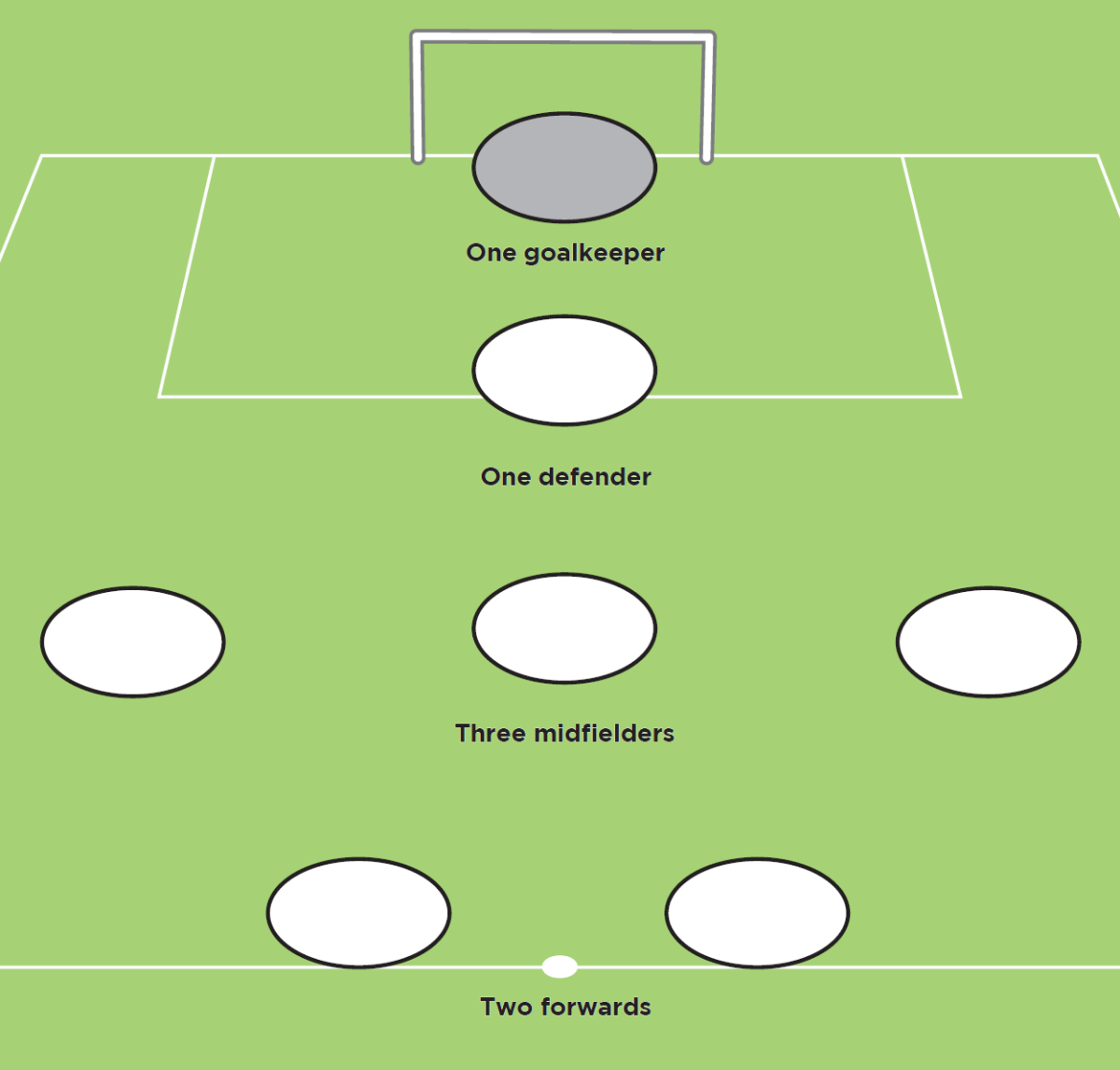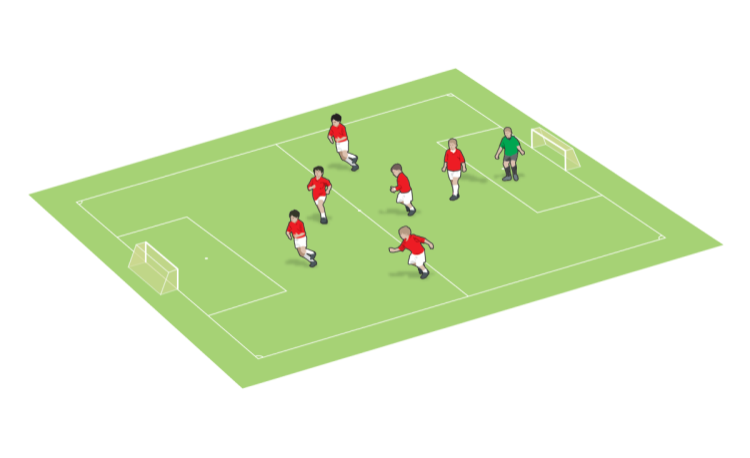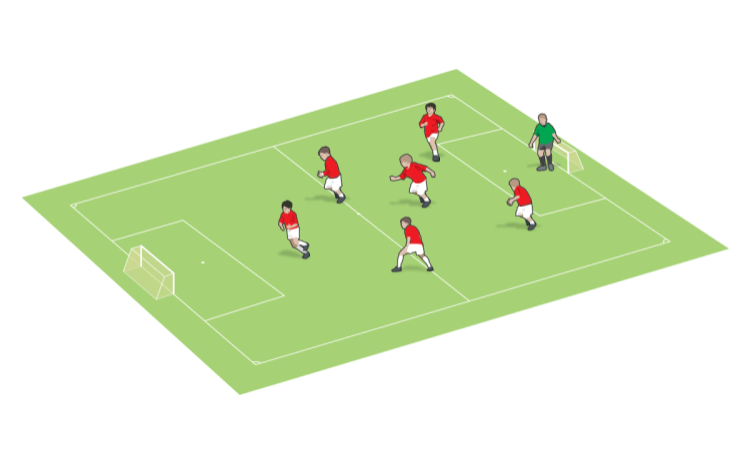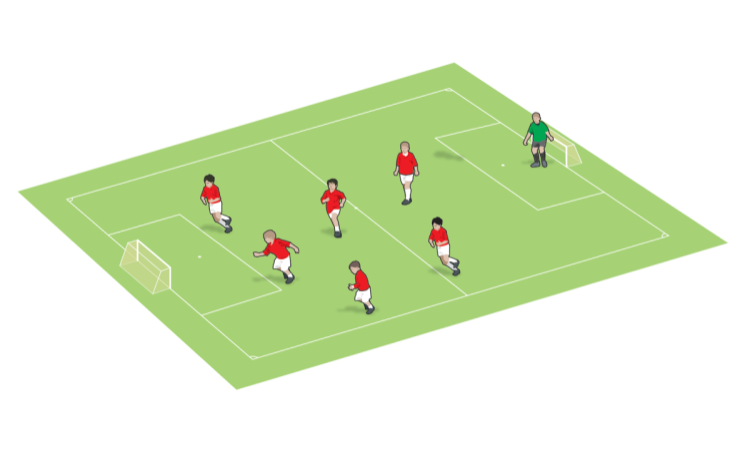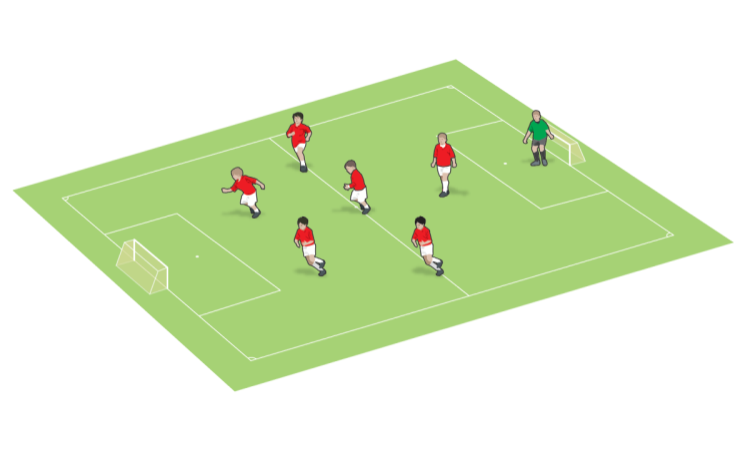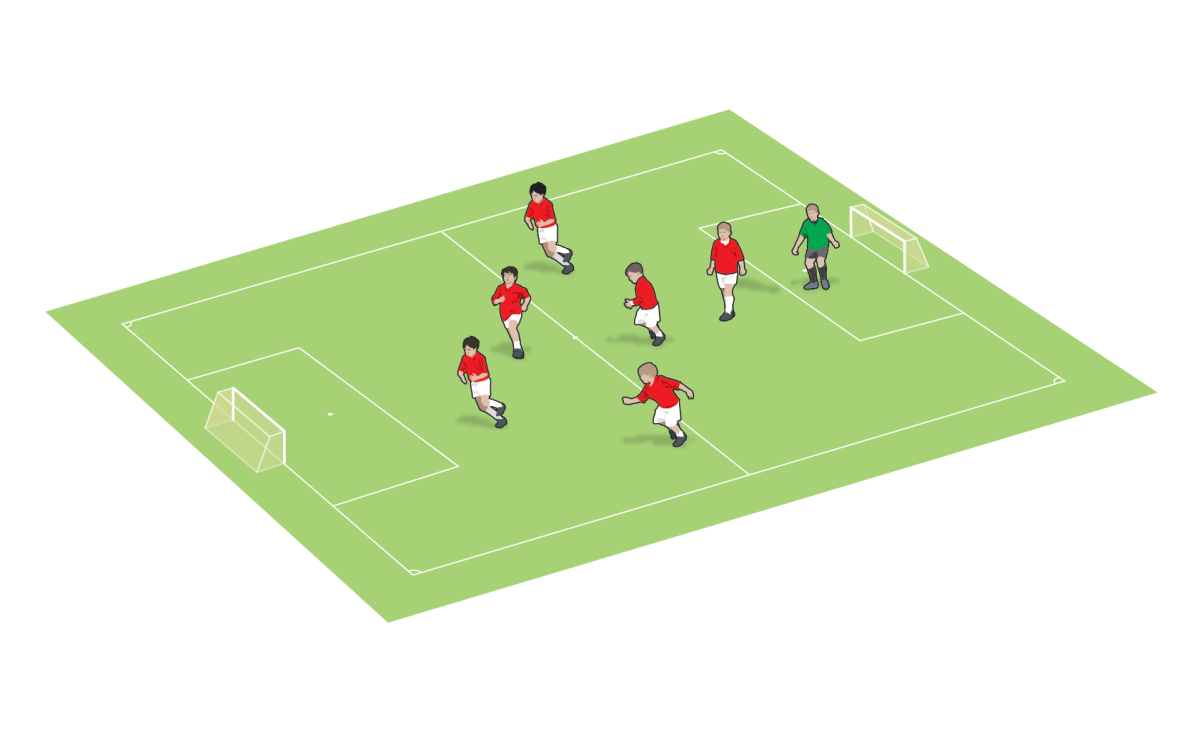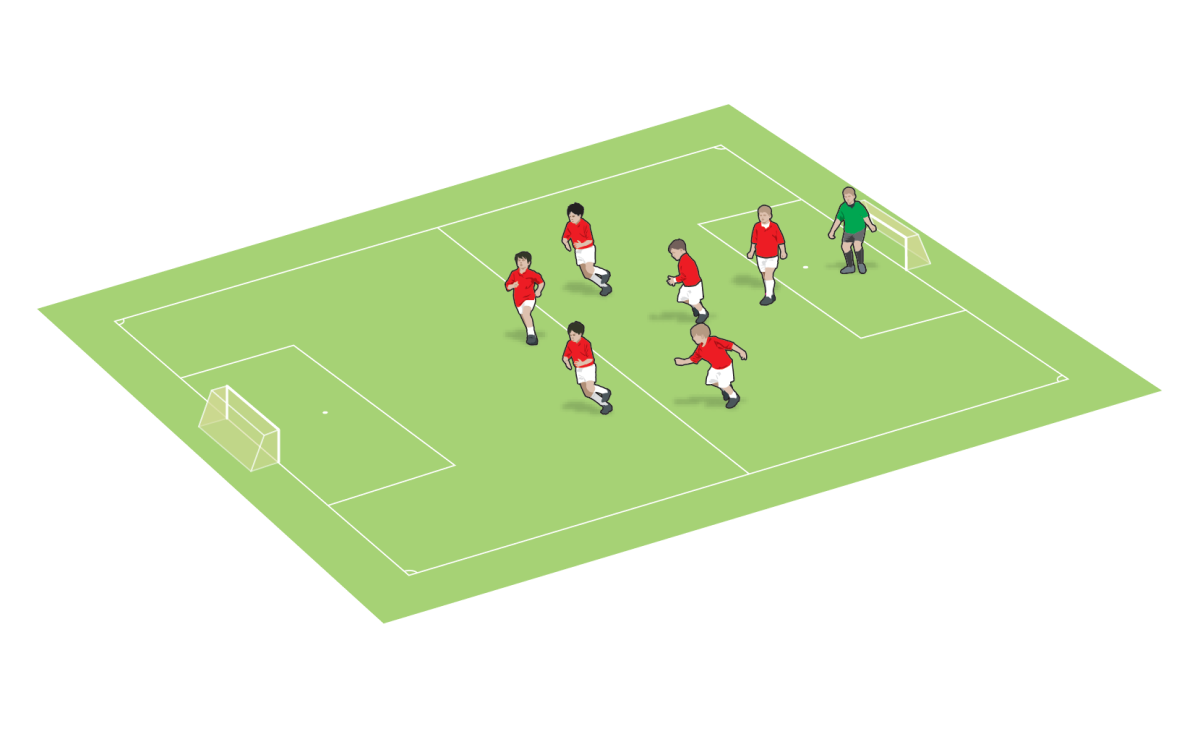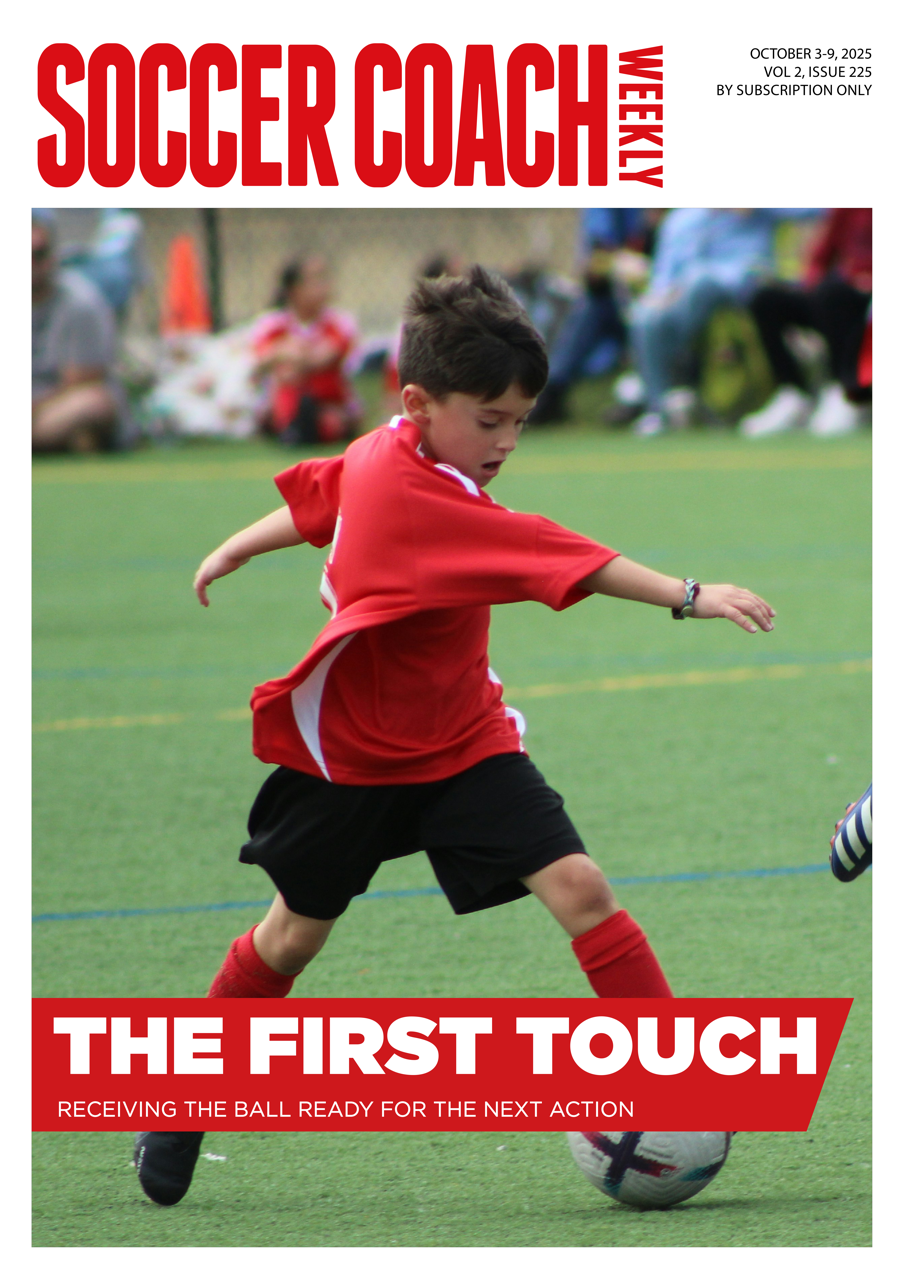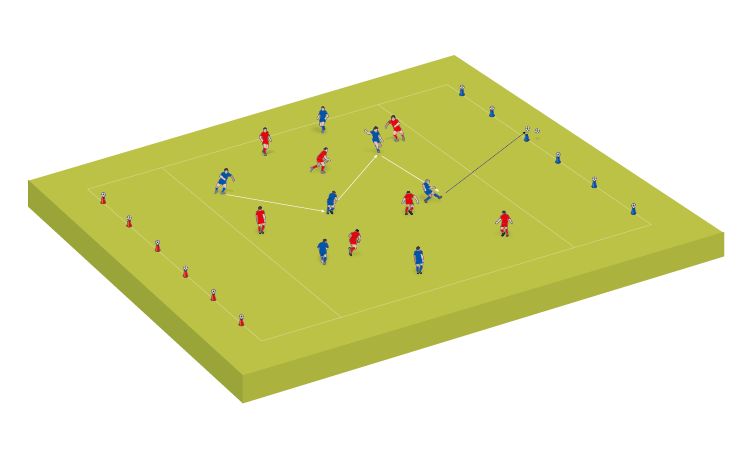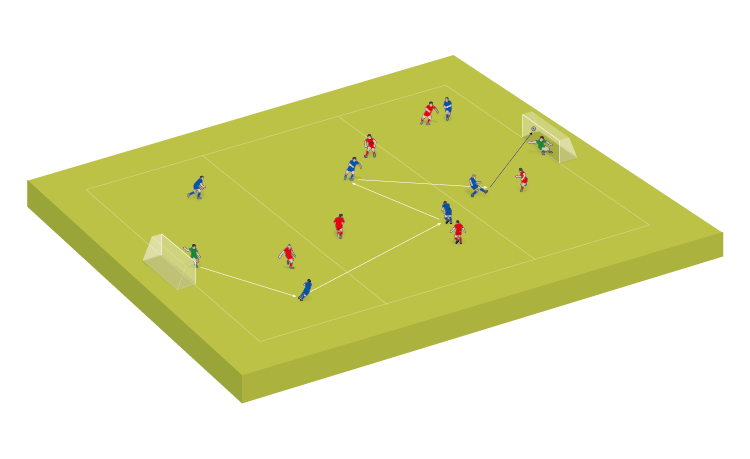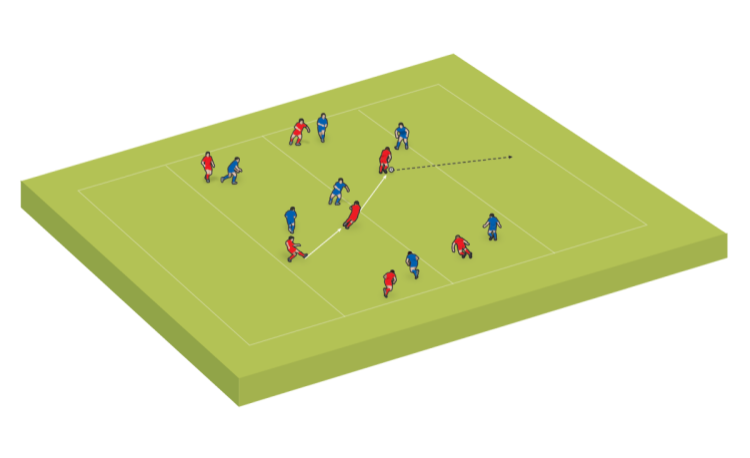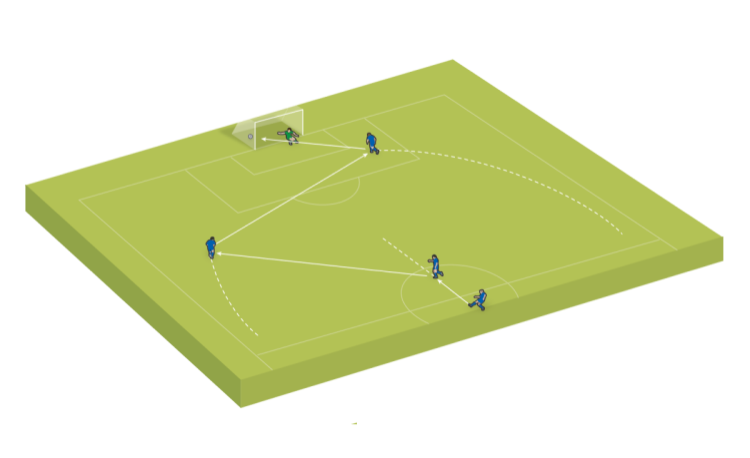7-a-side formation: 1-3-2
Why choose this 7v7 formation? Review the pros and cons, in possession and out of possession principles, and each position
Progresses from: 1-2-1 (4/5-a-side)
Progresses to: 3-2-1-2 (9-a-side)
PROS OF THIS FORMATION |
CONS OF THIS FORMATION |
|
|
|
|
|
|
7v7 1-3-2 - IN-POSSESSION SUMMARY
IN-POSSESSION PROS |
IN-POSSESSION CONS |
|
|
|
|
1-3-2 IN-POSSESSION - BY POSITION
Goalkeeper
This is arguably the formation which puts the biggest emphasis on the goalkeeper being able to play with their feet.
In most other formations, there are at least two defenders, making it easier for the goalkeeper to play out because they are likely to have an option either side of them.
In this shape, if the goalkeeper receives a pass from the defender, they will probably have to look to pass to one of the wide players. This increases the distance over which they need to play the ball, and requires a high level of accuracy.
If the goalkeeper chooses to give the ball to the defender, it is likely this player will be closely marked, so the placement of the pass will need to be precise.
There is also a much greater need for the goalkeeper to alter their position to support the player on the ball.
In most other formations, the goalkeeper can mainly stay in the centre of the goal, as this is usually where a defender or midfielder would want to pass the ball back to them and means they are in a good position to pass the ball to the next player.
However, when there is only one defender, as in this formation, they may have to move away from this central position to make a different angle to receive the pass or to create alternative passing lines.
Defenders
As the only player within the defensive unit, the defender is likely to come under pressure every time they receive the ball.
With most of their team-mates further up the pitch, it is important that they find a way to play forward.
The sole defender will not only need to be comfortable receiving the ball under pressure, but must also be able to move away from their opponent and go from facing their own goal to facing forwards.
This requires skills not normally associated with defenders, like shielding and turning.
Once they have done this, they will need to retain the ball for a bit longer. Rather than passing the ball immediately to a team-mate, who will more than likely be closely marked, quite often the better option is to travel with the ball and drive up the pitch.
This will force another opponent to close them down, drawing that opponent away from the previous player they were marking. That player is now a better option to pass to, as they will be in more space.
The key is the timing of the pass - leave it too late and it could be blocked by the opponent closing them down; pass too soon and the opponent could still be quite close to the intended target, giving them the opportunity to press or intercept the ball.
Related Files
- The wide players may have to position themselves behind, rather than ahead of, the ball or come off the wing to be a viable passing option
- One forward stays high, while the other drops deep to find space
- This formation puts the biggest emphasis on a goalkeeper being able to play with their feet
- The sole defender must be comfortable with receiving the ball under pressure and moving away from their opponent
Wide players
When a team plays with two wide midfield players, they usually receive the ball from either the defender or the central midfielder.
If a defender is in possession, a wide player provides them with a good option to pass to, because they are usually close by and provide an angle ahead of the ball.
However, when there is just one defender, this relationship is not as strong due to the different position in which the defender is likely to receive the ball. Having only one defender can therefore make it more difficult for the wide players to get on the ball.
This means the wide players must identify when they need to alter their position so that they are still a viable option for the defender.
This may involve them having to position themselves behind, rather than ahead of, the ball or they may need to come off the wing.
This movement can also be useful when the goalkeeper has the ball. Identifying the correct time to move to an area the ’keeper can play the ball into makes it easier for the team to keep the ball and progress up field.
This shape puts more emphasis on wide players’ positioning and understanding of where the player on the ball needs them to be, rather than their skill on the ball and their ability to beat an opponent.
Central midfielder
The central midfielder must think carefully about their positioning and the need to change it depending on which team-mate has the ball and where on the pitch they are.
In other formations, they should be in the central corridor between the defensive and attacking lines. In this shape, however, because there is just one defender and two forwards, the midfielder can play an important part in helping the team build up or getting the ball forward quickly.
When the goalkeeper has the ball, the centre-back is likely to come under pressure from the opposing team’s forward. If the defender can draw the forward to one side of the pitch, the central midfielder can drop into the space that has been created.
"With two forwards, one of them can drop into space while the other stays high..."
The timing of their movement is important, as is the way they receive the ball. The player should be open when receiving the ball, to allow them to play forward quickly.
The other option is to occupy the same side as the defender, which opens up passing lines to at least one of the strikers, allowing the ball to be played upfield quickly.
These concepts can be challenging for young players to understand. To simplify it, challenge the central midfielder to make just one of these movements and then build on it as their understanding improves.
At first, we might just ask them to identify the space to drop into and then move into it. Receiving to play forward can be introduced later.
Forwards
The two forwards have the opportunity to work together and combine with one another. This formation also allows them to work on dropping into space.
At 11-a-side, we often talk about a striker dropping into the area between the opposition’s defensive and midfield units, so they can receive the ball in space, away from the centre-backs.
At seven-a-side, we always need at least one player to stay high up the pitch to maintain one of the key in-possession principles: creating space.
Playing with two forwards means one of them can drop into space while the other stays high. This is especially effective in this formation as there is likely to be lots of space for them to exploit.
Playing with just one central midfielder, who is sometimes asked to move out of their usual position, will produce space for one of the strikers to drop into.
As coaches, we can keep this concept really simple for the players to understand: can one of you stay high and the other come short?
Once they receive the ball in this space, they then have a number of options available to them, including dribbling, passing forward and combining with the other forward.
7V7 1-3-2 - OUT-OF-POSSESSION SUMMARY
OUT-OF-POSSESSION PROS |
OUT-OF-POSSESSION CONS |
|
|
|
|
|
|
1-3-2 OUT-OF-POSSESSION - BY POSITION
Goalkeeper
In this formation, the sole defender is likely to be directly up against the opposition’s forward, particularly as the midfield and attacking units will often be further up the pitch.
The defender cannot be expected to win every single contest, and so the goalkeeper is likely to face a number of 1v1 situations.
They will, therefore, have plenty of opportunity to work on how to approach these moments.
A goalkeeper can use their starting position to prevent a forward from having the opportunity to go through on goal.
If they start higher up the pitch, they can put themselves in a position to intercept the pass or clear the ball if the striker has a heavy touch.
The goalkeeper will need to concentrate on their starting position and will have to make a decision: do they stay in position and face the 1v1, or do they think they can get to the ball before the striker?
Defender
In this formation, the sole defender has to do the important job of protecting the goalkeeper, and the goal, on their own.
They will need to be able to defend effectively in a range of different 1v1 situations.
For instance, they must be able to defend from behind. An example could be when an opponent has the ball and is facing away from goal - the defender must prevent them from turning. Or it might involve winning a race with a striker to get to the ball first.
In this formation, the defender will often find themselves outnumbered, for example in a 1v2 situation. This gives them a chance to work on the key principle of defending an overload: delaying. Can they slow down the opponent on the ball while also cutting out or covering the pass to the other attacker?
When we are preparing players to defend an overload, it is important to remember that it is only likely to last for a small amount of time as a team-mate should be recovering to help out.
- Wide players must prevent the ball from being played into the central area, due to the lack of numbers there
- Introduce the concept of a forward dropping back to fill some of the midfield space and help the team become more compact and harder to play through
- With only one defender, the goalkeeper’s starting position is crucial to preventing lots of 1v1s
- When the defender is outnumbered, they must slow down the opponent on the ball while also covering the pass to the other attacker
Wide players
As with the other positions in this formation, the wide players will need to win their individual battles with their direct opponent.
In their particular duels, the wide players can be given more specific direction on how to defend.
With just one defender in this formation, the centre of the pitch is extremely vulnerable due to the lack of numbers protecting it. The best way to protect this key area is to stop the ball from going into it.
When the opposition winger is in possession in a wide channel, our wide player should look to dictate where the attacker goes, by stopping them from coming inside.
They should keep their opponent in a wide position, where they will either look to play back or cross the ball. Though allowing the player to cross the ball is not ideal, it is a lot better than them driving towards the goal.
Central midfielder
One of the main defensive roles for the central midfielder is to stop the ball getting to the opposition striker.
To do this effectively, rather than marking a player, the central midfielder should look to fill a space that prevents the opponent with the ball passing it to their striker.
Doing so will force the player on the ball to pass out wide or to a team-mate who is not as far upfield as the striker, thus slowing down the attack and giving a number of our players an opportunity to recover and help protect the goal.
The central midfielder will need to learn to scan while the opposition has possession, in particularly when the ball is in their defensive third.
"The central midfielder should look to fill a space that prevents a pass to their striker..."
This will help them identify the position of the striker and enable them to position themselves in the passing lane.
Though this might mean leaving the opposition’s midfielder free, it is better that the ball goes to this player rather than the striker, who will be positioned a lot higher up the pitch.
Ideally, when the midfielder positions themselves in the passing lane, they do so goal-side of the opposition’s midfielder.
If they can do this, they are still in a position to engage the opposition midfielder should that player receive the ball.
Forwards
Having two forwards provides an opportunity for these players to press the opposition’s defenders. They must negotiate which of them goes to press, and which holds back.
The pressing player should try to force the player on the ball to pass to a certain team-mate, preferably a wide player to prevent them from playing the ball centrally.
We can also introduce the concept of a forward dropping back to fill some of the midfield space and help the team become more compact and harder to play through.
The key is that only one of the strikers does this, while the other remains in their position, so that they are able to apply some pressure onto the defenders and also be an outlet should the team win the ball back.
This will be a tough challenge for the two strikers. It is important that they recognise when to stay high as a pair and when one can, or should, drop into the midfield area.
We cannot expect them to be able to do this effectively straight away. But, hopefully, they will start to think about where they should be stood when an opposition defender has the ball.
Newsletter Sign Up
Coaches Testimonials

Gerald Kearney, Downtown Las Vegas Soccer Club

Paul Butler, Florida, USA

Rick Shields, Springboro, USA

Tony Green, Pierrefonds Titans, Quebec, Canada
Subscribe Today
Discover the simple way to become a more effective, more successful soccer coach
In a recent survey 89% of subscribers said Soccer Coach Weekly makes them more confident, 91% said Soccer Coach Weekly makes them a more effective coach and 93% said Soccer Coach Weekly makes them more inspired.
*includes 3 coaching manuals
Get Weekly Inspiration
All the latest techniques and approaches
Soccer Coach Weekly offers proven and easy to use soccer drills, coaching sessions, practice plans, small-sided games, warm-ups, training tips and advice.
We've been at the cutting edge of soccer coaching since we launched in 2007, creating resources for the grassroots youth coach, following best practice from around the world and insights from the professional game.
